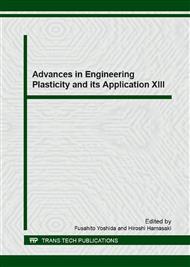[1]
ICAO. Aerodrome Design Manual Part 6 – Frangibility, First Edition (2006).
Google Scholar
[2]
J.A. Artero-Guerrero, J. Pernas-Sánchez, J. López-Puente, and D. Varas. Experimental study of the impactor mass effect on the low velocity impact of carbon/epoxy woven laminates, Compos. Struct. 133 (2015) 774–781.
DOI: 10.1016/j.compstruct.2015.08.027
Google Scholar
[3]
Johnsen Jorgen. Wing impactor for testing of aviation masts, Master thesis, NTNU (2016).
Google Scholar
[4]
J.F.M. Wiggeraad and D. G Zimcik. Technical notes on Frangibility of approach lighting structures at airports, NLT-TP (2001) 064.
Google Scholar
[5]
Alan baker, Stuart Dutton and Donald Kelly. Composite Materials for Aircraft Structures – Second Edition, AIAA education series.
Google Scholar
[6]
Paul Wambua, Jan Ivens and Ignaas Verpoest. Natural fibers: can they replace glass in fiber reinforced plastics?, Compos Sci and Technol. 63 (2003) 1259-1264.
DOI: 10.1016/s0266-3538(03)00096-4
Google Scholar
[7]
Kuruvilla Joseph, Romildo Dias, Toledo Filho, Beena James, Sabu Thomas and Laura hecker de Carvalho. A revire on sial fiber reinforced polymer composites, Rev. Bras. Eng. Agric. Ambient. 3 (1999) 367-379.
DOI: 10.1590/1807-1929/agriambi.v3n3p367-379
Google Scholar
[8]
A. May-Pat, A. Valadez-Gonz´alez, and P. J. Herrera-Franco. Effect of fiber surface treatments on the essential work of fracture of HDPE-continuous henequen fiber-reinforced composites. Polym Test, 32 (2013) 1114–1122.
DOI: 10.1016/j.polymertesting.2013.06.006
Google Scholar
[9]
K. G Satyanarayana, K. Sukumaran, P.S. Mukherjee, C. Pavithran and S.G.K. Pillai. Natural Fiber –Polymer Composites, Cem. Concr. Compos. 12 (1990) 117-136.
DOI: 10.1016/0958-9465(90)90049-4
Google Scholar
[10]
H. Ku ⇑, H. Wang, N. Pattarachaiyakoop, M. Trada. A review on the tensile properties of natural fiber reinforced polymer composites, Compos Part B, 42 (2011) 856–873.
DOI: 10.1016/j.compositesb.2011.01.010
Google Scholar
[11]
P.J. Herrera-Franco, A. Valadez-Gonzalez. Mechanical properties of continuous natural fiber reinforced polymer composites, Compos Part A, 35 (2004) 339-345.
DOI: 10.1016/j.compositesa.2003.09.012
Google Scholar
[12]
G. Balaganesan,R. Velmurugan, M. Srinivasan, N.K. Gupta, K. Kanny. Energy absorption and ballistic limit of nanocomposite laminates subjected to impact loading, Int J Impact Eng, 74 (2014) 57-66.
DOI: 10.1016/j.ijimpeng.2014.02.017
Google Scholar


